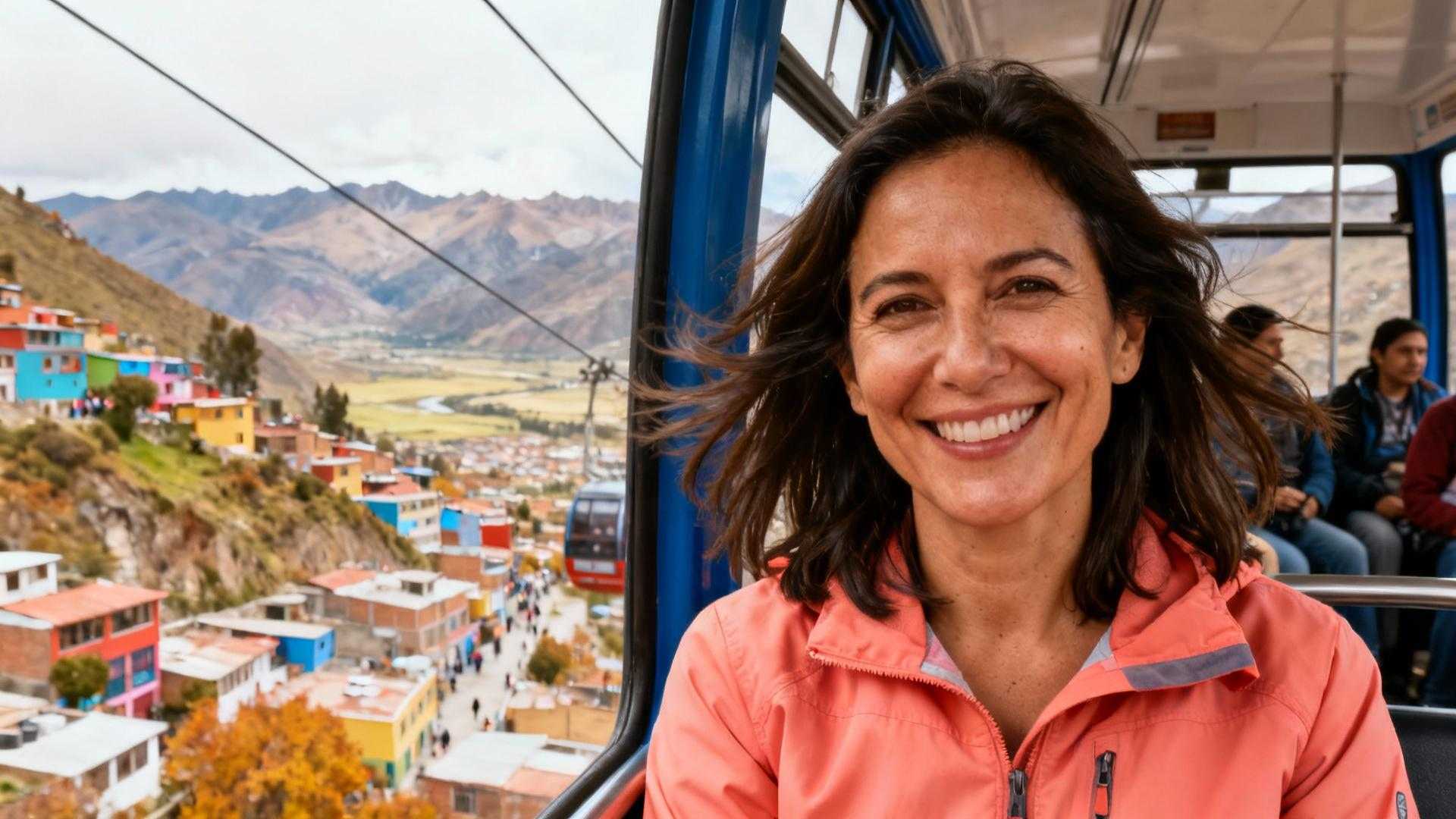I stumbled onto Medellín’s Metrocable during morning rush hour, wedged between a grandmother clutching grocery bags and a construction worker heading to the valley below. The 8-passenger gondola lurched upward, and suddenly I wasn’t just riding public transit—I was witnessing Colombia’s proudest urban revolution unfold beneath my feet at 30 cents per trip.
What started in 2004 as South America’s first cable car system designed purely for public transportation has transformed into something far more powerful: a social equalizer soaring over 733 families in hillside barrios who once spent 2.5 hours commuting to work. Now they reach downtown in 30 minutes, and I’m experiencing their daily miracle alongside them.
The French-built Poma gondolas glide at 10 miles per hour over neighborhoods where armed gangs once made streets too dangerous for police. Today, international tourists photograph the vibrant street art of Comuna 13 below while local students study for exams in adjacent seats. That’s the revolution—accessibility replacing isolation, community pride replacing fear, all for the cost of a candy bar.
The engineering that defied Medellín’s impossible terrain
Why conventional transit failed these mountain communities
Medellín’s Aburrá Valley creates slopes so steep that regular buses physically cannot navigate the inclines leading to informal settlements clinging to hillsides at 1,500 meters elevation. The city’s metro system, while excellent, stops where the mountains begin. For decades, residents in Santo Domingo Savio and neighboring barrios faced a brutal choice: grueling 5-hour round-trip commutes on foot and overcrowded minibuses, or economic isolation.
The monocable detachable gondola solution
The $24 million Line K pioneered a technology that would inspire similar transformative transit projects across Latin America—detachable grip gondolas that connect to a moving cable at stations but maintain constant motion between stops. Six lines now span 9.1 miles across 19 stations, carrying 30,000 riders daily with seamless metro integration. No tourist gimmick—this is how Paisas actually get to work, school, and markets every single day.
The $0.30 ride that outperforms $800 helicopter tours
Cost disruption that changes travel economics entirely
Medellín’s tourism industry hawks helicopter tours at $800+ for aerial city views lasting 15 minutes. The Metrocable offers superior panoramas of the Andes valley, glimpses into authentic hillside life, and a genuine cultural education for less than a third of the price of a New York subway ride. Purchase a single integrated metro ticket and you’ve unlocked the entire system—no upcharges, no tourist pricing, no VIP cabins. Just you and the people who built this city’s transformation.
What your fare actually supports
Every 30-cent ride funds the public infrastructure that reduced informal housing by 15% and opened university pathways for kids who once dodged cartel bullets. Tourism dollars flowing to private helicopter companies extract value; Metrocable fares reinvest in the communities you’re witnessing below. One resident group famously used participatory budget funds not for sports facilities, but to send local youth to university. That’s where your transit money goes—into futures, not Instagram moments.
The cultural immersion that guidebooks cannot manufacture
Riding with Medellín’s morning commute reality
Board Line K between 7-9 AM and you’ll experience what transformation actually looks like: mothers balancing children and work bags, vendors transporting goods to hillside markets, students comparing homework. Nobody’s performing for tourists here—this is life as it’s genuinely lived in a city that refused to accept geographic inequality as destiny.
Comuna 13’s story visible from above
The Metrocable soars directly over neighborhoods that house 700-year-old cultural traditions maintained by families who survived decades of violence. Today’s vibrant street art tells those survival stories, but the real narrative unfolds in the faces of residents who can now access jobs, education, and healthcare without losing half their day to brutal commutes. That’s the revolution helicopter tours miss entirely—the quiet dignity of restored connectivity.
How October 2025 creates optimal conditions
Weather advantages for clear mountain views
October marks the transition from wet to dry season, delivering clearer skies for panoramic photography without December’s Christmas tourist surge or August’s Feria de las Flores crowds. Morning mist lifts by 9 AM to reveal the full Andes valley, while afternoon clarity peaks for stunning golden hour perspectives. Temperatures hover comfortably between 17-28°C year-round, but October offers the best visibility window before November rains reduce clarity by 50%.
Cultural timing that respects community rhythms
October’s Colombian Independence celebrations on the 12th showcase local pride without tourist-focused commercialization. You’ll witness authentic Paisa culture during a shoulder season when working-class communities maintain their daily routines rather than adapting to peak-season visitor demands. Flight deals from US/UK/AU hubs drop 15-25% compared to December pricing, making October both culturally respectful and economically smart.
Frequently asked questions about Medellín’s Metrocable experience
Which Metrocable line offers the best experience for first-time visitors?
Line K remains the iconic route, connecting the city center to Santo Domingo Savio with the most dramatic hillside views and strongest transformation narrative. Line L extends to Parque Arví’s nature reserve for a peaceful forest escape, while Line H showcases the Comuna 13 street art district. Purchase the integrated metro ticket to explore multiple lines without additional fares.
Is it disrespectful to photograph residents and their homes from the cable cars?
Absolutely photograph the cityscape and mountains, but avoid zooming into private homes or taking close-ups of residents without permission. These are living neighborhoods, not tourist attractions. Many locals appreciate respectful visitors but resent invasive photography that treats their daily lives as spectacle. When in doubt, focus your lens on architecture and landscapes rather than people.
Can I combine the Metrocable with Comuna 13 walking tours?
Yes, and that’s highly recommended for understanding the complete transformation story. Book tours led by local guides who actually lived through Comuna 13’s evolution from violence to vibrant cultural center. The Metrocable provides aerial perspective; ground-level walking tours deliver personal testimonies and historical context you cannot get from gondolas. Combined, they create a comprehensive picture of urban regeneration that changed 30,000 lives.
